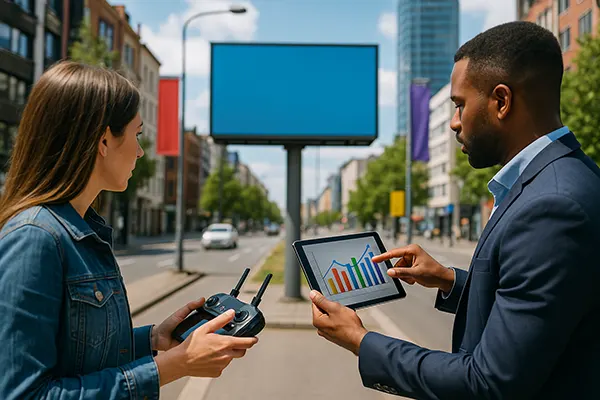Marketing Analytics for Outdoor Advertising: How to Measure the Effectiveness of Signs, Banners and Flags

Outdoor advertising remains a powerful tool for building brand awareness and attracting potential customers in 2025. Yet, without proper analytics, even the most eye-catching banners or signs may fail to deliver measurable results. Marketing analytics allows businesses to track the performance of their outdoor campaigns, evaluate return on investment, and make data-driven decisions. This article explains how to measure the effectiveness of outdoor advertising using modern tools, metrics and analytical methods.
Key Metrics for Measuring Outdoor Advertising Performance
Accurate measurement begins with defining the right metrics. The main indicators of outdoor advertising effectiveness include reach, impressions, engagement, and conversion rate. Reach helps determine how many people have seen a billboard or banner, while impressions measure total exposures within a period. In turn, engagement rates indicate the level of audience interaction, often tracked through online searches or visits after ad exposure.
Conversion tracking has become increasingly common thanks to the integration of offline and online data. Businesses can now analyse how outdoor ads influence website traffic, app downloads or in-store purchases. By combining GPS data, unique promo codes and QR tags, companies can link physical ad exposure directly to digital actions. This hybrid approach ensures a more precise understanding of customer behaviour.
Another key aspect is cost efficiency. Calculating cost per thousand impressions (CPM) or cost per conversion allows marketers to assess whether their spending brings proportional results. When analytics reveal that certain locations or ad types outperform others, budgets can be optimised accordingly, maximising visibility and profitability.
Technological Tools for Outdoor Marketing Analytics
Modern analytics tools have transformed how outdoor advertising campaigns are monitored. Mobile data providers, GPS trackers and AI-driven software enable marketers to collect real-time insights on audience movement and exposure. For instance, anonymised location data from smartphones helps estimate traffic density and identify high-performing areas for billboard placement.
Computer vision and digital recognition technologies also play an important role. Cameras installed near billboards can detect the number of vehicles or pedestrians passing by, analyse dwell time, and even estimate audience demographics. This data helps advertisers adapt messages and creative content for maximum relevance and impact.
QR codes, NFC tags and short URLs bridge the gap between offline and online environments. When people scan a QR code on a banner or use a custom link, marketers can track their journey — from outdoor interaction to online conversion. This level of detail provides a complete picture of how offline exposure influences digital engagement and sales.
Integrating Outdoor Data with Digital Marketing Channels
The true power of outdoor marketing analytics lies in integration. By combining data from outdoor campaigns with digital sources such as Google Ads, social media and CRM systems, businesses can create a 360-degree view of their audience. This approach helps identify which outdoor channels drive the most online interactions and which audience segments respond best.
One popular integration method involves geofencing. This technology allows marketers to set virtual boundaries around billboards or banners and deliver targeted ads to users’ mobile devices when they enter the area. Such synergy between physical and digital touchpoints strengthens brand recognition and boosts engagement rates.
Another integration strategy includes synchronising outdoor campaigns with real-time events. For example, updating digital banners based on weather conditions, sports events or local news can make messages more relevant and time-sensitive. Analytics tools then measure how these contextual factors affect user response and brand awareness.
Challenges and Limitations in Outdoor Advertising Analytics
Despite technological progress, outdoor advertising analytics still faces certain challenges. Privacy laws, such as the GDPR and national data protection acts, restrict how audience data can be collected and processed. Marketers must ensure transparency, using only aggregated and anonymised data to respect consumer privacy.
Another limitation is environmental variability. Factors like weather, lighting, or local construction can influence visibility and exposure. Therefore, analytics should account for these external variables to maintain accuracy in performance measurement. Continuous monitoring and data normalisation are essential to obtain reliable results.
Lastly, human factors also play a role. People’s perception and memory are subjective — not every individual exposed to an ad will notice or remember it. Surveys, focus groups and brand lift studies can complement quantitative data, providing valuable qualitative insights into audience attitudes and recall rates.

Future of Outdoor Advertising Analytics
As of 2025, the future of outdoor marketing analytics lies in deeper automation and predictive modelling. Artificial intelligence now allows systems to forecast campaign outcomes before launch, helping brands allocate resources more effectively. Predictive analytics can determine the best locations, times, and creative variations for maximum engagement.
Augmented reality (AR) and interactive displays are reshaping traditional outdoor advertising. These formats generate measurable engagement through user interactions, allowing for advanced data collection. For example, an AR billboard campaign can track how many users interacted with the 3D elements or shared them on social media.
In addition, sustainability metrics are gaining importance. Companies increasingly evaluate the environmental impact of outdoor campaigns — including energy consumption of digital screens and materials used for banners. Integrating these metrics into analytics frameworks ensures that marketing remains both effective and socially responsible.
Best Practices for Accurate Outdoor Campaign Measurement
To achieve reliable results, marketers should follow a consistent analytical process. Begin by setting clear objectives — awareness, engagement, or direct sales — and define measurable KPIs for each goal. Next, ensure that tracking mechanisms, such as QR codes or geolocation tools, are implemented before the campaign launch.
Regular reporting and data validation are crucial. Comparing results across different time frames and locations helps identify patterns and optimise future campaigns. Data visualisation dashboards make performance evaluation easier for marketing teams and stakeholders.
Finally, integrate insights from multiple sources. Combining outdoor analytics with online marketing and CRM data provides a complete understanding of customer journeys. When all channels work in harmony, outdoor advertising becomes not just visible but strategically measurable — turning traditional banners and signs into powerful data-driven assets.
